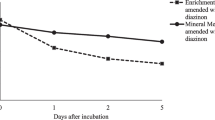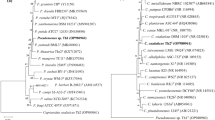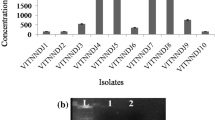Abstract
One strain of bacterium IM-4, capable of degrading imazethapyr (IMZT), was isolated from the IMZT-contaminated soil. The isolate was identified as Pseudomonas sp. according to its physiological characteristics, biochemical tests, and 16S rRNA gene phylogenetic analysis. This strain could utilize IMZT as the sole carbon and energy source. About 73.4% of the 50 mg l−1 initially added IMZT was degraded after 7 days of inoculation with strain IM-4. This strain also showed the capability to degrade other imidazolinone herbicides such as imazapyr, imazapic, and imazamox. The inoculation strain IM-4 to soil treated with IMZT resulted in a higher degradation rate than in noninoculated soil regardless if the soil was sterilized or nonsterilized. Inoculation of strain IM-4 could also mitigate the phytotoxic effects of IMZT on the growth of maize.



Similar content being viewed by others
References
Ding W, Bai H, Cheng Z, Qu JJ, Xu WJ (2008) Isolation and identification of imazethapyr degradable bacteria and its degradation characteristics. Huan Jing Ke Xue 29:1359–1362 (in Chinese)
Elazzouzi M, Mekkaoui M, Zaza S, Madani ME, Zrineh A, Chovelon JM (2002) Abiotic degradation of imazethapyr in aqueous solution. J Environ Sci Health B 37:445–451
Ellis LBM, Roe D, Wackett LP (2006) The University of Minnesota Biocatalysis/Biodegradation Database: the first decade. Nucl Acids Res 34:517–521
Ferrari A, Brusa T, Rutili A, Canzi E, Biavati B (1994) Isolation and characterization of Methanobrevibacter oralis sp nov. Curr Microbiol 29:7–12
Goetz AJ, Lavy TL, Gburjr EE (1990) Degradation and field persistence of imazethapyr. Weed Sci 38:421–428
Gu LF, Jiang JD, Li XH, Shinawar WA, Li SP (2007) Biodegradation of ethametsulfuron-methyl by Pseudomonas sp. SW4 isolated from contaminated soil. Curr Microbiol 55:420–426
Holt JG, Krieg NR, Sneath PHA, Staley JT, Williams ST (1994) Bergy’s manual of determinative bacteriology, 9th edn. Williams & Wilkins, Baltimore, pp 626–640
Ishiki RR, Ishiki HM, Takashima K (2005) Photocatalytic degradation of imazethapyr herbicide at TiO2/H2O interface. Chemosphere 58:1461–1469
Karpouzas DG, Walker A (2000) Factors influencing the ability of Pseudomonas putida epI to degrade ethoprophos in soil. Soil Biol Biochem 32:1753–1762
Lane DJ (1991) 16S/23S rRNA sequencing. In: Stackebrandt E, Goodfellow M (eds) Nucleic acid techniques in bacterial systematics. Wiley, Chichester, pp 371–375
Loux M, Reese K (1993) Effect of soil type and pH on persistence and carryover of imidazolinones herbicides. Weed Technol 7:452–458
Loux M, Liebl R, Slife F (1989) Availability and persistence of imazaquin, imazethapyr, and clomazone in soil. Weed Sci 37:259–267
Mangels G (1991) IMZT herbicide. In: Shaner D, Connor S (eds) The imidazolinones herbicides. CRC Press, Boca Raton, FL, pp 191–209
Struthers JK, Jayachandran K, Moorman TB (1998) Biodegradation of atrazine by Agrobacterium radiobacter J14a and use of this strain in bioremediation of contaminated soil. Appl Environ Microbiol 64:3368–3375
Wang XD, Liu XJ, Wang HL, Dong QX (2007) Utilization and degradation of imazaquin by a naturally occurring isolate of Arthrobacter crystallopoietes. Chemosphere 67:2156–2162
Worthing CR, Hance RJ (1991) The pesticide manual, 9th edn. British Crop Protection Council, Farnham, Surrey
Zanardini E, Arnoldi A, Boschin G, D’Agostina A, Negri M, Sorlini C (2002) Degradation pathways of chlorsulfuron and metsulfuron-methyl by a Pseudomonas fluorescens strain. Ann Microbiol 52:25–37
Zhang XH, Zhang GS, Zhang ZH, Xu JH, Li SP (2006) Isolation and characterization of a dichlorvos-degrading strain DDV-1 of Ochrobactrum sp. Pedosphere 16:64–71
Acknowledgments
This work was supported by National Foundation Program for Nature Resources of Science and Technology (2005DKA21201-11), Social Development Program Fund of Jiangsu Province (No. BS2007056), and Scientific Research Achievements of University Industrialization Fund of Jiangsu Province (JHZD07-003).
Author information
Authors and Affiliations
Corresponding author
Rights and permissions
About this article
Cite this article
Huang, X., Pan, J., Liang, B. et al. Isolation, Characterization of a Strain Capable of Degrading Imazethapyr and Its Use in Degradation of the Herbicide in Soil. Curr Microbiol 59, 363–367 (2009). https://doi.org/10.1007/s00284-009-9442-7
Received:
Revised:
Accepted:
Published:
Issue Date:
DOI: https://doi.org/10.1007/s00284-009-9442-7




